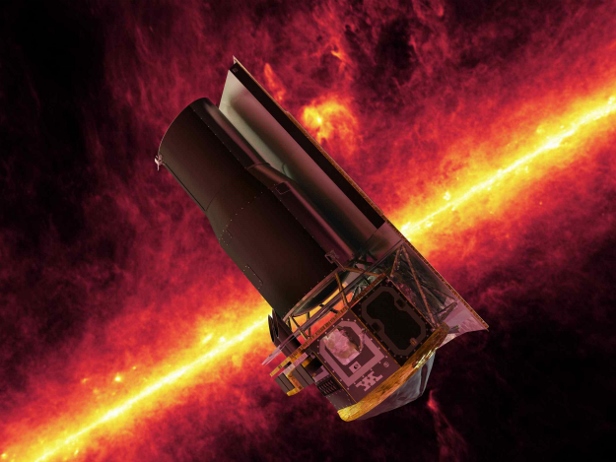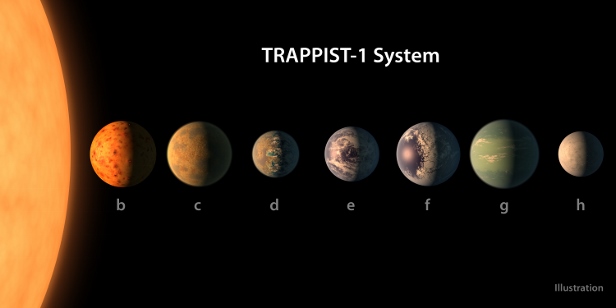Celebrating 15 years of the Spitzer Space Telescope
NASA’s iconic infrared telescope has reached a tremendous milestone, revealing many unknown details about our solar system and beyond in the process

The Spitzer Space Telescope whizzes in front of a brilliant, infrared view of the Milky Way galaxy’s plane in this artistic depiction. Image credit: NASA/JPL
Initially scheduled for a minimum 2.5-year primary mission, NASA’s Spitzer Space Telescope has gone far beyond its expected lifetime – and is still going strong after 15 years.
Launched into a solar orbit on 25 August 2003, Spitzer was the final of NASA’s four Great Observatories to reach space. The space telescope has illuminated some of the oldest galaxies in the universe, revealed a new ring around Saturn, and peered through shrouds of dust to study newborn stars and black holes. Spitzer assisted in the discovery of planets beyond our solar system, including the detection of seven Earth-size planets orbiting the star TRAPPIST-1, among other accomplishments.
“In its 15 years of operations, Spitzer has opened our eyes to new ways of viewing the universe,” says Paul Hertz, director of the Astrophysics Division at NASA Headquarters in Washington, United States. “Spitzer’s discoveries extend from our own planetary backyard, to planets around other stars, to the far reaches of the universe. And by working in collaboration with NASA’s other Great Observatories, Spitzer has helped scientists gain a more complete picture of many cosmic phenomena.”
Spitzer detects infrared light – most often heat radiation emitted by warm objects. On Earth, infrared light is used in a variety of applications, including night-vision instruments.
With its infrared vision and high sensitivity, Spitzer has contributed to the study of some of the most distant galaxies in the known universe. The light from some of those galaxies travelled for 13.4 billion years to reach Earth. As a result, scientists see these galaxies as they were less than 400 million years after the birth of the universe.
Among this population of ancient galaxies was a surprise for scientists: “big baby” galaxies that were much larger and more mature than scientists thought early-forming galaxies could be. Large, modern galaxies are thought to have formed through the gradual merger of smaller galaxies. But the “big baby” galaxies showed that massive collections of stars came together very early in the universe’s history.
Studies of these very distant galaxies relied on data from both Spitzer and the Hubble Space Telescope, another one of NASA’s Great Observatories. Each of the four Great Observatories collects light in a different wavelength range. By combining their observations of various objects and regions, scientists can gain a more complete picture of the universe.
“The Great Observatories program was really a brilliant concept,” says Michael Werner, Spitzer project scientist at NASA’s Jet Propulsion Laboratory in Pasadena, California, United States. “The idea of getting multispectral images or data on astrophysical phenomenon is very compelling, because most heavenly bodies produce radiation across the spectrum. An average galaxy like our own Milky Way, for example, radiates as much infrared light as visible wavelength light. Each part of the spectrum provides new information.”
In recent years, scientists have utilised Spitzer to study exoplanets, or planets orbiting stars other than our Sun, although this was not something the telescope’s designers anticipated.
With Spitzer’s help, researchers have studied planets with surfaces as hot as stars, others thought to be frozen solid, and many in between. Spitzer has studied some of the nearest known exoplanets to Earth, and some of the most distant exoplanets ever discovered.
Spitzer also played a key role in one of the most significant exoplanet discoveries in history: the detection of seven, roughly Earth-size planets orbiting a single star. The TRAPPIST-1 planetary system was unlike any alien solar system ever discovered, with three of its seven planets located in the “habitable zone,” where the temperature might be right for liquid water to exist on the planets’ surfaces. Their discovery was an enticing step in the search for life elsewhere in the universe.

Spitzer is vital in the analysis of the famous TRAPPIST-1 system. Image credit: NASA/JPL-Caltech
“The study of extrasolar planets was still in its infancy when Spitzer launched, but in recent years, often more than half of Spitzer’s observation time is used for studies of exoplanets or searches for exoplanets,” says Lisa Storrie-Lombardi, Spitzer’s project manager at JPL. “Spitzer is very good at characterising exoplanets, even though it wasn’t designed to do that.”
Some other major discoveries made using the Spitzer space telescope include:
- The largest known ring around Saturn, a wispy, fine structure with 300 times the diameter of Saturn.
- First exoplanet weather map of temperature variations over the surface of a gas exoplanet. Results suggested the presence of fierce winds.
- Asteroid and planetary smash-ups. Spitzer has found evidence for several rocky collisions in other solar systems, including one thought to involve two large asteroids.
- Recipe for “comet soup.” Spitzer observed the aftermath of the collision between NASA’s Deep Impact spacecraft and comet Tempel 1, finding that cometary material in our own solar system resembles that around nearby stars.
- The hidden lairs of newborn stars. Spitzer’s infrared images have provided unprecedented views into the hidden cradles where young stars grow up, revolutionizing our understanding of stellar birth.
- “Buckyballs” in space. Buckyballs are football-shaped carbon molecules discovered in laboratory research with multiple technological applications on Earth.
- Massive clusters of galaxies. Spitzer has identified many more distant galaxy clusters than were previously known.
- One of the most extensive maps of the Milky Way galaxy ever compiled, including the most accurate map of the large bar of stars in the galaxy’s centre, created using Spitzer data from the Galactic Legacy Mid-Plane Survey Extraordinaire project, or GLIMPSE.
Spitzer has logged over 106,000 hours of observation time. Thousands of scientists around the world have utilised Spitzer data in their studies, and Spitzer data is cited in more than 8,000 published papers.
Spitzer’s primary mission ended up lasting 5.5 years, during which time the spacecraft operated in a “cold phase,” with a supply of liquid helium cooling three onboard instruments to just above absolute zero. The cooling system reduced excess heat from the instruments themselves that could contaminate their observations. This gave Spitzer very high sensitivity for “cold” objects.
In July 2009, after Spitzer’s helium supply ran out, the spacecraft entered a so-called “warm phase.” Spitzer’s main instrument, called the Infrared Array Camera (IRAC), has four cameras, two of which continue to operate in the warm phase with the same sensitivity they maintained during the cold phase.
Spitzer orbits the Sun in an Earth-trailing orbit (meaning it literally trails behind Earth as the planet orbits the Sun) and has continued to fall farther and farther behind Earth during its lifetime. This now poses a challenge for the spacecraft, because while it is downloading data to Earth, its solar panels do not directly face the Sun. As a result, Spitzer must use battery power during data downloads. The batteries are then recharged between downloads.
“Spitzer is farther away from Earth than we ever thought it would be while still operating,” says Sean Carey, manager of the Spitzer Science Center at Caltech in Pasadena, California, United States. “This has posed some real challenges to the engineering team, and they’ve been extremely creative and resourceful to keep Spitzer operating far beyond its expected lifetime.”
In 2016, Spitzer entered an extended mission dubbed “Spitzer Beyond.” The spacecraft is currently scheduled to continue operations into November 2019, more than 10 years after entering its warm phase.
In celebration of Spitzer’s 15 years in space, NASA has released two new multimedia products: The NASA Selfies app for iOS and Android, and the Exoplanet Excursions VR Experience for Oculus and Vive, as well as a 360-video version for smartphones. Spitzer’s incredible discoveries and amazing images are at the centre of these new products.
JPL manages the Spitzer Space Telescope mission for NASA’s Science Mission Directorate, Washington. Science operations are conducted at the Spitzer Science Center at Caltech in Pasadena, California. Spacecraft operations are based at Lockheed Martin Space Systems Company, Littleton, Colorado. Data are archived at the Infrared Science Archive housed at the IPAC at Caltech.
Keep up to date with the latest news in All About Space – available every month for just £4.99. Alternatively you can subscribe here for a fraction of the price!




